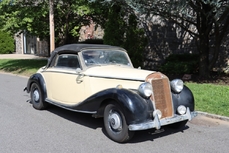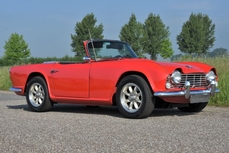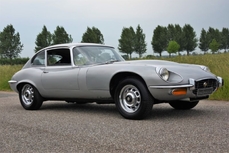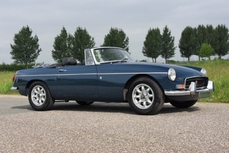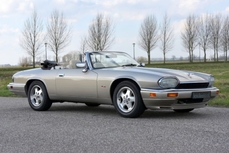Mercedes-Benz 170V Sport Roadster 1939
General description :
1939 Mercedes 170V Sport Roadster
Mercedes-Benz started with the production of 170-series cars in 1970. For the time a great succes for Mercedes-Benz: over two hunderd thousand cars left the Mercedes factory, spread over different generations 170.
From 1931 until 1943 the 170 (W15) was produced. An advanced vehicle at that days wit hindependant suspension of the rear axle, steering wheel lock, lubrication system and hydraulic brakesystem on all wheels. When Mercedes-Benz introduced the 170 (W28) in 1934, the angular design changed to a curvy design.
This prewar Mercedes-Benz is from the 170V (W136) series that was introduced at the 1936 Autoshow in Berlin, Germany. The first roadcars in this serie were produced in 1937 with a 4-cylinder line engine. In 1944, the productionfacility in Stuttgart-Unterturkheim was destroyed by the allies. The “V” in the type 170V stands for “Vorne” because it was built as a front engine car.
The Mercedes 170V (W136) was available as: 2 doors and 4 doors Ihnenlenker, limousine, Cabriolet B, Cabriolet A, Sport roadster and open tourer.
Only a few cars with a roadster body were built, making this 170V Sport Roadster a very unique appearance today. Mercedes-Benz Classic in Stuttgart confirmed that this chassis left the factory with a sport roadster body and delivered as a new car in Kopenhagen, Denmark. In the file with this car are old documents from Denmark present. This car is performed in the beautiful two-tone color black / beige combined with a red leather interior.
The restoration of this Mercedes 170 was performed with a great eye for quality by a specialist, rarely we saw a restored Mercedes in this quality. The bodywork was finished perfectly, making this 170 a perfect fit of the body parts and also the paintwork is exceptionally tight. The engine compartment is fantastically detailed and has been built with great precision. The leather interior is also of very high quality, this combined with the beautiful classic dashboard which makes this Mercedes complete.
This Mercedes 170V Sport Roadster is present in our showroom, you are welcome to come and see this unique car.
For more information please contact our sales team by sales@lexclassics.nl or 0031-416-342474.
Lex Classics is active in the international classic car business since 1998 and we are specialist in trading English sport cars and exclusive classic cars. We have our own workshop with 4 specialist mechanics where we prepare and maintain classic cars. We sell all our classic cars with a detailed information file, with as much historical information as available.
Lex Classics is located in the south of the Netherlands, 1 hour from Amsterdam, 1,5 hours from Brussels and 1,5 hours from Dusseldorf. You are very welcome to visit us. If you need more information, detailed pictures or you would like to make an appointment, please contact our sales team by mail sales@lexclassics.nl or by phone 0031-416-342474.
This Classic car is easy to register in every European country. We can also deliver classic cars with German Registration (H-Kenzeigen). Within Europe there are no import taxes. We can also help you with transport.
1939 Mercedes-Benz 170V Sport Roadster is listed for sale on ClassicDigest in Havenweg 22aNL-5145 NJ Waalwijk by Lex Classics Cars B.V. for €225000.
Car Facts
Car type : Car Make : Mercedes-Benz Model : 170V Model Version : Sport Roadster Engine size : 1.7 Model Year : 1939 Sub type : Convertible Location : Havenweg 22aNL-5145 NJ Waalwijk Vehicle Registration : Undefined
225000 €
People who viewed this Mercedes-Benz 170V also viewed similar Mercedes-Benz listed at ClassicDigest
Other cars listed for sale by this dealer
About Mercedes-Benz
In the annals of automotive history, the journey of Mercedes-Benz is a tale that unfolds with the ingenuity of its founding pioneers. In the year 1886, Karl Benz crafted the Benz Patent Motorwagen, a creation that would go down in history as the world's inaugural automobile. Unbeknownst to him, this moment marked the genesis of what would evolve into the most illustrious premium car manufacturer globally. The financial underpinning of this pioneering venture, interestingly, was provided by Karl Benz's wife, Bertha Benz, demonstrating a remarkable partnership that would set the tone for Mercedes-Benz's legacy.A parallel narrative emerged not far away, as Daimler-Motoren-Gesellschaft, founded by Gottlieb Daimler and Wilhelm Maybach, entered the scene. In 1901, they unveiled their automobile under the now-famous moniker "Mercedes," meaning "godsend" in Spanish. This name was bestowed upon the car at the behest of Emil Jellinek's daughter, the distributor for Daimler-Motoren-Gesellschaft. The wheels of innovation were set in motion.
Fast forward to 1926, a pivotal year that witnessed the merger of Daimler with Benz & Cie., culminating in the birth of Daimler-Benz. The amalgamation saw the adoption of "Mercedes-Benz" as the distinguished trademark for their automobiles, fusing the legacies of two visionary entities into one.
Contrary to perceptions of conservatism, the trajectory of Daimler-Benz unfolds as a chronicle of industry firsts. From the introduction of the honeycomb radiator to the float carburetor, and the pioneering implementation of four-wheel brakes in 1924, Daimler-Benz consistently pushed the boundaries of automotive innovation. The diesel-powered Mercedes-Benz 260 D in 1936 marked the inception of diesel engines in passenger cars. The iconic Mercedes-Benz 300SL Gullwing made history as the first car with direct fuel injection, albeit the Gutbrod's tiny 2-stroke engine can claim precedence.
Safety innovations became a hallmark, with Béla Barényi's patented safety cell design in the "Ponton"-models in 1951, featuring front and rear crumple zones. The W116 450SEL 6.9 saw the introduction of the Anti-Lock Brake system (ABS), another pioneering safety feature. From the first production airbags and beyond, the legacy of "firsts" continued to be etched into the fabric of Daimler-Benz.
Over its centennial journey, Mercedes-Benz has not merely produced cars but has sculpted automotive icons. The SSKL, 710 SSK Trossi Roadster, 770K Grosser, 540K Spezial Roadster, 300SL Gullwing, w100 600 Pullman, w111 280SE 3.5 Flachkühler, w113 230SL Pagoda, w109 300 SEL 6.3, and w201 2.3-16 Cosworth stand testament to the brand's commitment to engineering excellence.
The roaring Silver Arrows, or "Silberpfeile," including the W 25, W 125, W154, W165, and W196, created a legacy of dominance on the racetrack. These machines were not merely cars; they were expressions of precision, speed, and an indomitable spirit that left their competitors in the dust.
As Mercedes-Benz marches into the future, it does so not just as an automaker but as a custodian of a legacy, a torchbearer of innovation, and a beacon of automotive excellence. The road ahead is sure to witness the continued fusion of cutting-edge technology, timeless design, and an unwavering commitment to setting new standards in the world of automobiles.
One luminary figure who left an indelible mark was Béla Barényi, often heralded as the "father of passive safety" for his pioneering work in safety engineering. His patented safety cell design, featuring front and rear crumple zones, became a hallmark of Mercedes-Benz's commitment to occupant safety, setting new standards that reverberated throughout the automotive world.
Moving through the chronicles, the collaborative genius of Wilhelm Maybach, alongside Gottlieb Daimler, laid the foundation for Daimler-Motoren-Gesellschaft. Their innovations not only birthed the first Mercedes but established a culture of relentless pursuit of technological excellence that remains integral to Mercedes-Benz's DNA.
In the post-merger era of 1926, Ferdinand Porsche emerged as a prominent figure within Mercedes-Benz. His work on the Mercedes-Benz S-Type, a supercharged race car, garnered acclaim and set the stage for a legacy that extended far beyond the marque. Porsche's impact would later extend to his eponymous company, but his influence at Mercedes-Benz during those formative years was pivotal.
As the 20th century progressed, the legendary Rudolf Uhlenhaut emerged as a key figure. Uhlenhaut, an accomplished engineer and the driving force behind the iconic Silver Arrows, played a crucial role in Mercedes-Benz's dominance in motorsports. His engineering prowess and attention to detail were instrumental in creating some of the most formidable racing cars of the era.
In the latter half of the century, figures like Bruno Sacco, the head of design at Mercedes-Benz from 1975 to 1999, left an indelible imprint on the brand's aesthetic identity. Sacco's design philosophy, characterized by clean lines and timeless elegance, shaped iconic models like the W126 S-Class and the W201 190E, solidifying Mercedes-Benz's reputation for luxury and sophistication.
The narrative would be incomplete without acknowledging the contributions of engineers like Hans Scherenberg, whose leadership in the 1970s ushered in a new era of technological innovation at Mercedes-Benz. Scherenberg's tenure saw the development of groundbreaking technologies, including the Anti-Lock Brake system (ABS) and the introduction of airbags in production cars.

















